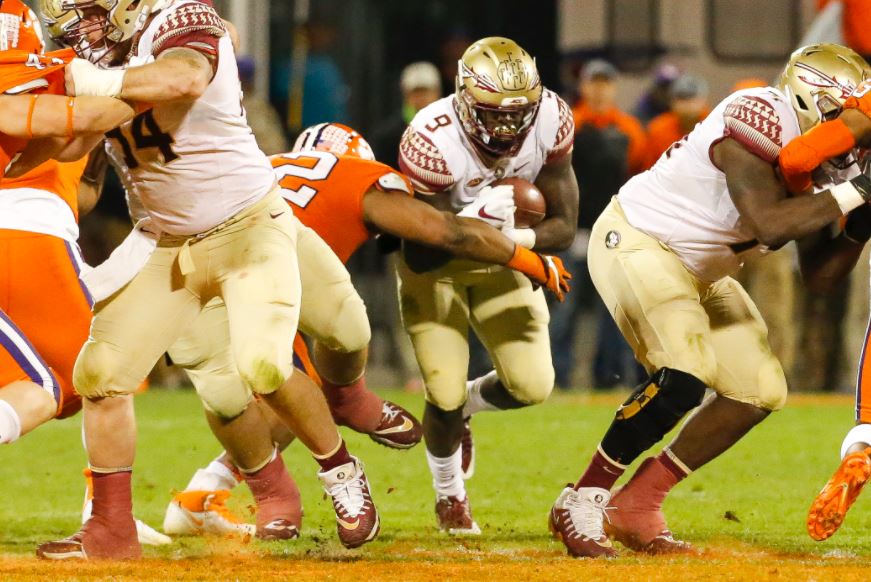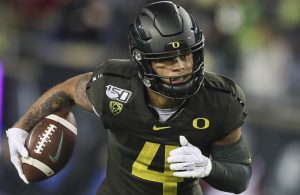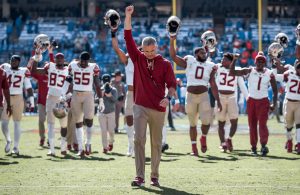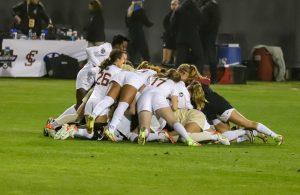- Sunday Seminole Summary: FSU Football Adds Pair of WR Transfers
- Sunday Seminole Summary: FSU Football Exits ESD With Top-15 Class
- Sunday Seminole Summary: FSU Soccer Tops BYU for Third National Championship
- Sunday Seminole Summary: FSU Soccer Advances to National Championship Match
- Seminole Sunday Summary: FSU Soccer Heads Back to College Cup
- Seminole Sunday Summary: FSU Soccer Reaches Sweet 16; Football Tops Boston College
- Seminole Sunday Summary: FSU Soccer Wins ACC, Advances to Second Round of NCAA Tournament; FSU Football Rallies Past Miami
- Seminole Sunday Summary: FSU Soccer Tops Wake on OT to Advance to ACC Final
- Seminole Sunday Summary: FSU Football Crushes UMass for Third Straight Win
- Seminole Sunday Summary: FSU Soccer Stays Perfect with Pair of Wins
Did Jacques Patrick Make the Right Decision?
- By Clint Eiland
- Updated: January 14, 2018
 Jeremy Esbrandt/FSU athletics
Jeremy Esbrandt/FSU athleticsJacques Patrick’s decision to spurn the NFL Draft and return to Florida State for his senior season might be one of the more interesting situations yet.
Before his announcement on Wednesday, most considered it a coin flip on whether or not Patrick would be leaving. His 2017 season was his best yet, both statistically and performance wise. Patrick showed improved vision and a willingness to muscle through contact.
He was also a leader in the locker room, providing toughness and consistency for the younger players on offense. Both freshmen quarterback James Blackman and running back Cam Akers were helped immensely by his presence.
His numbers weren’t overly impressive, but 919 total yards on 5.6 yards per carry with seven touchdowns would still pique the interest of some NFL teams. The film would back him up when they got down to examining his impact on the team.
All in all, Patrick had a good year that he could use to springboard to a draft selection. The arrival of new coach Willie Taggart and his offensive system might also bring uncertainty with Patrick’s role in the offense. No fans would have opposed a decision to depart.
So why is there increased discussion around Patrick in particular? Some fans on social media almost seemed upset with him, mainly because they felt that Patrick was returning to a team that would not utilize him correctly. It could also potentially cause running back recruits to doubt their spot on the FSU roster, since they’d have at least four blue-chips above them on the depth chart in 2018.
Before we go any further, we need to emphasize that declaring for the draft is a case-by-case basis. People naturally value different things. Perhaps Patrick’s home life has given him the opportunity to stay all four years of school without worrying about money.
Maybe he realizes that his future in the league will be short and he wants to finish the degree. Point being that we will never know all the factors that went in to the decision, and at the end of the day, only Jacques Patrick knows what is best for him.
That being said, here are a couple of considerations.
The biggest point against Patrick’s choice seems to be his fit in Taggart’s offense. The complexities and intricacies won’t be discussed here, since a general overview of Taggart and his philosophy is sufficient. Recent results at Oregon and South Florida would seem to suggest that power backs are not used much (if at all) in his offense.
It’s not necessarily wrong. Power backs are generally not the type of runner Taggart used with his formations in recent years. That being said, it needs to be clarified that the concept of having two different style running backs is present within Taggart’s play-calling.
Some numbers from USF and Oregon back up that assertion. While in Tampa, Taggart had two seasons where two USF running backs received at least 70 carries (2015 and 2016). Both years were the most successful of his tenure. Marlon Mack was the all-around quality starter who had a proficiency for great cutting and home-run style plays.
Meanwhile, D’Ernest Johnson made his name as the workhorse who powered through tackles. Johnson wasn’t really a power back, but he had some similarities with Patrick. In 2016, Mack and Johnson combined for 2,250 total yards and 28 total touchdowns.
The story stays consistent while at Oregon. Royce Freeman started at running back and tallied an incredible 1,639 total yards and 16 touchdowns. Royce Freeman and Jacques Patrick actually share some key traits, though Freeman has more speed than Patrick does at every gear. Regardless, two options behind Freeman were Tony Brooks-James and Kani Benoit, who combined for 1,262 yards and 13 touchdowns of their own.
Taggart’s system thrives when he can attack a defense in various ways; there’s no overt focus on one type of running back style. It helps that part of Taggart’s coaching history involves a stop at Stanford under Jim Harbaugh. Taggart and his coaching were key in turning Toby Gerhart into a Heisman Trophy contender, so it’s not like Taggart is unfamiliar with power running backs.
Patrick will certainly have an instrumental role in the offense given his performance in 2017. Even if his style doesn’t completely vibe with the new system, good players have a way of making an impact on the field.
But an even more important factor might be the best reason for Patrick to return: veteran presence.
2017 wasn’t exactly peachy for Florida State. Both the on-field and off-field drama took a toll on those inside the locker room. Near the end of the season, there were players publicly making their displeasure known and airing out dirty laundry. Here’s the shocking part: it could have been even worse.
The Seminoles have had just one transfer from the program, and it was Mavin Saunders due to lack of playing time. Locker room leadership was obviously in short supply this season, but Patrick was an exception. His attempts to motivate his team did not go unnoticed.
The way he carried himself and how he continuously gave maximum effort were absolutely essential to achieving bowl-eligibility. It’s fair to say that if Patrick was not 100 percent dedicated, the Seminoles would be sitting on the couch during bowl season.
That type of veteran presence will be valued highly during the coaching transition. Taggart and staff are walking in to a program where they won’t be familiar with many of the players. Those connections will grow as time progresses, but in the meantime, veterans like Patrick will be essential in uniting the team.
Too many fans view draft decisions in a vacuum. The question of “How high will he go?” should be considered, but this is a decision which will affect a good portion of his adult life. Patrick has a lot of variables in the equation that he needs to account for.
Coming back to Florida State does have a certain amount of risk. But given everything mentioned above, it’s still a decision that makes sense.




You must be logged in to post a comment Login